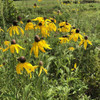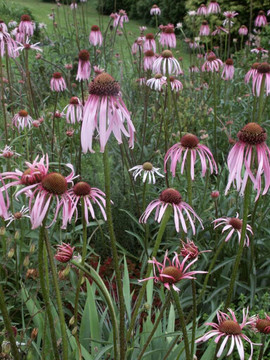
Ratibida pinnata - GRAY-HEADED CONEFLOWER (YELLOW CONEFLOWER)
Easy, modest and very showy-looking native perennial and wildflower with elegant drooping petals and big (2-3”) flowers. It has a beautiful, airy structure, and the stems with big yellow flowers often dart in the wind. It usually doesn't grow upright, especially with more moisture. It provides valuable food for wildlife, is used in landscaping for its long flowering term (over 4 weeks), and can be used as a cut flower; the seed heads may be used in dried arrangements. The crushed cones are anise-scented. It may not be the longest-lasting perennial, but it will self-seed and stay close by...not many plants have so many advantages!
Gray-Headed coneflower is very easy to grow and naturalizes readily, so it's a great wildflower for cottage gardens, drier flower beds, pollinator gardens, prairie plantings and up to woodland edges, bird gardens, along roads, bigger rain gardens, disturbed areas and wild habitat restorations on a small or large scale. It can be planted in small groups or in masses. It prefers drier soils but can grow even in clayish soil if it is not too wet.
It looks great with tall Agastache, Asclepias tuberosa, Echinacea purpurea, Monarda, Liatris, Sorghastrum, etc.
Picture copyright: US Perennials nursery
Blooming Time: July - September
Size: up to 5´ tall, about 2' wide (narrower habitus, sometimes a bit inclined growth). Spacing 1-1.5´
USDA Zones: 3 to 7, possibly even higher
Culture: sun, half-sun, half-shade, any type soil (sandy, clay, calcareous), but not too wet. Tolerates lots of heat and drought
Moisture Needs: medium, dry-medium, dry
Origin: drier prairies and savannas of Southeast, Midwest, Northeast, and Northern US, and the plains of Texas: AL, AR, CT, FL, GA, IA, IL, IN, KS, KY, LA, MA, MI, MN, MO, MS, NE, NY, OH, OK, PA, SC, SD, TN, VA, VT, WI, WV and Ontario.
Deer/Rabbit Resistant: yes/most likely yes. Herbivores such as groundhogs or livestock browse the foliage, so it can decline in heavily browsed pastures.
Attracts Butterflies or Pollinators: This perennial offers valuable food to native bees, but also feeds wasps, beetles, flies and butterflies. Plants host caterpillars of the Silvery Checkerspot butterfly and several moths.
Attracts Hummingbirds: no, but Goldfinches eat the seeds in late summer.
Pot Size: 3.5" x 4" perennial pot

Ratibida pinnata - GRAY-HEADED CONEFLOWER (YELLOW CONEFLOWER)
Easy, modest and very showy-looking native perennial and wildflower with elegant drooping petals and big (2-3”) flowers. It has a beautiful, airy structure, and the stems with big yellow flowers often dart in the wind. It usually doesn't grow upright, especially with more moisture. It provides valuable food for wildlife, is used in landscaping for its long flowering term (over 4 weeks), and can be used as a cut flower; the seed heads may be used in dried arrangements. The crushed cones are anise-scented. It may not be the longest-lasting perennial, but it will self-seed and stay close by...not many plants have so many advantages!
Gray-Headed coneflower is very easy to grow and naturalizes readily, so it's a great wildflower for cottage gardens, drier flower beds, pollinator gardens, prairie plantings and up to woodland edges, bird gardens, along roads, bigger rain gardens, disturbed areas and wild habitat restorations on a small or large scale. It can be planted in small groups or in masses. It prefers drier soils but can grow even in clayish soil if it is not too wet.
It looks great with tall Agastache, Asclepias tuberosa, Echinacea purpurea, Monarda, Liatris, Sorghastrum, etc.
Picture copyright: US Perennials nursery
Blooming Time: July - September
Size: up to 5´ tall, about 2' wide (narrower habitus, sometimes a bit inclined growth). Spacing 1-1.5´
USDA Zones: 3 to 7, possibly even higher
Culture: sun, half-sun, half-shade, any type soil (sandy, clay, calcareous), but not too wet. Tolerates lots of heat and drought
Moisture Needs: medium, dry-medium, dry
Origin: drier prairies and savannas of Southeast, Midwest, Northeast, and Northern US, and the plains of Texas: AL, AR, CT, FL, GA, IA, IL, IN, KS, KY, LA, MA, MI, MN, MO, MS, NE, NY, OH, OK, PA, SC, SD, TN, VA, VT, WI, WV and Ontario.
Deer/Rabbit Resistant: yes/most likely yes. Herbivores such as groundhogs or livestock browse the foliage, so it can decline in heavily browsed pastures.
Attracts Butterflies or Pollinators: This perennial offers valuable food to native bees, but also feeds wasps, beetles, flies and butterflies. Plants host caterpillars of the Silvery Checkerspot butterfly and several moths.
Attracts Hummingbirds: no, but Goldfinches eat the seeds in late summer.
Pot Size: 3.5" x 4" perennial pot
Customer Reviews
-
Don't Hesitate
Excellent arrival and the packing great. The top and bottom growth are better than other suppliers out. I Highly Recommend US Perennials for your native and non native plant needs
-
Young plants
Excellent little plants., and they obviously are well cared for. They have been planted for about two weeks, and I do not expect a a lot of blooming, just good growth and establishment.






